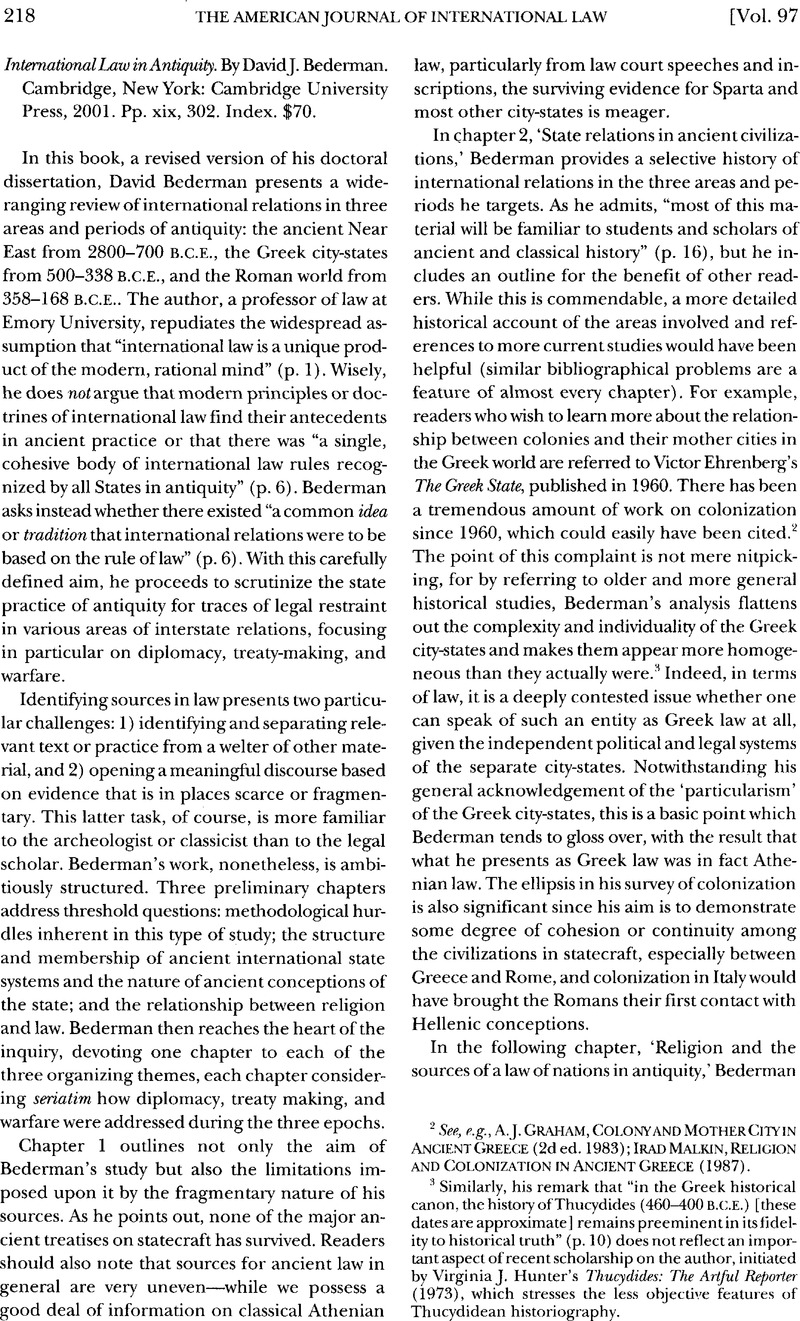No CrossRef data available.
Article contents
International Law in Antiquity. By David J. Bederman. Cambridge, New York: Cambridge University Press, 2001. Pp. xix, 302. Index. $70.
Published online by Cambridge University Press: 27 February 2017
Abstract

- Type
- Recent Books on International Law
- Information
- Copyright
- Copyright © American Society of International Law 2003
References
2 See, e.g., A.J. Graham, Colony And Mother Cltyin Ancient Greece (2ded. 1983); Iradmalkin, Religion And Colonization In Ancient Greece (1987).
3 Similarly, his remark that “in the Greek historical canon, the history of Thucydides (460-400 B.CE.) [these dates are approximate] remains preeminent in its fidelity to historical truth” (p. 10) does not reflect an important aspect of recent scholarship on the author, initiated by Virginia J. Hunter's Thucydides: The Artful Reporter (1973), which stresses the less objective features of Thucydidean historiography.
4 One misses, in particular, any reference to Walter Burkert's classic Greek Religion (1985) or to more modern treatments, for example, K. Tausend's Amphiktyonie und Symmachie (1992), of the Greek religious leagues known as amphictionies.
5 SeeC. P.Jones, Kinship Diplomacyin The Ancient World (1999). Jones's book is included in the bibliography, but its influence is not apparent in the text.
6 J. Rigsby, Asylia: Territorial Inviolabilityin The Hellenistic World (1996).
7 On matters of Roman religion, reference should be made to Mary Beard, John North, & Simon Price, Religions Of Rome (1998).
8 Bederman himself remarks that it “is with some reluctance I have titled this book as a treatment of international law in antiquity, and not of an ancient law of nations” (p. 14).
9 See Robert H. Bork, The Limits of ‘International Law,’ NATIONAL INTEREST, Winter 1989/1990, at 3,10; see also Robert H. Bork, Erosion of the President's Power in Foreign Affairs, 68 WASH. U. L.Q. 693, 695-97 (1990).
10 Articulated in The National Security Strategy of the United States of America, at <http://www.whitehouse.gov/nsc/ nss.pdf> (Sept. 17, 2002). See also Michael J. Glennon, Preempting Terrorism: The Case for Anticipatory Self-Defense, WEEKLY STANDARD, Jan. 28, 2002, at 7.
11 In addition to a bibliography and index, the book contains maps of the ancient Near East, Greece, and the Roman Mediterranean. The standard of production is good, but with typos at p. 18 n.13 (read “Fustel de Coulanges“) and p. 253 £13 (read “Olympiad“). Ataphos is glossed at pp. 260 and 264 as “the death of the human spirit;” it simply means “unburied.”




